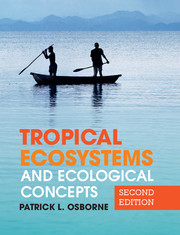Book contents
- Frontmatter
- Contents
- Preface
- Abbreviations and units
- Chapter 1 The tropical environment and climate
- Chapter 2 Dry, hot deserts and environmental factors
- Chapter 3 Grasslands and primary production
- Chapter 4 Savanna and population dynamics
- Chapter 5 Lakes, energy flow and biogeochemical cycling
- Chapter 6 Rivers, floodplains and estuaries
- Chapter 7 Wetlands and succession
- Chapter 8 Tropical rain forests and biodiversity
- Chapter 9 Mountains, zonation and community gradients
- Chapter 10 Mangroves, seagrasses and decomposition
- Chapter 11 Coral reefs and community ecology
- Chapter 12 Islands, archipelagos, biogeography and evolutionary ecology
- Chapter 13 Cities and human ecology
- Glossary
- References
- Index
- References
Chapter 4 - Savanna and population dynamics
Published online by Cambridge University Press: 05 June 2012
- Frontmatter
- Contents
- Preface
- Abbreviations and units
- Chapter 1 The tropical environment and climate
- Chapter 2 Dry, hot deserts and environmental factors
- Chapter 3 Grasslands and primary production
- Chapter 4 Savanna and population dynamics
- Chapter 5 Lakes, energy flow and biogeochemical cycling
- Chapter 6 Rivers, floodplains and estuaries
- Chapter 7 Wetlands and succession
- Chapter 8 Tropical rain forests and biodiversity
- Chapter 9 Mountains, zonation and community gradients
- Chapter 10 Mangroves, seagrasses and decomposition
- Chapter 11 Coral reefs and community ecology
- Chapter 12 Islands, archipelagos, biogeography and evolutionary ecology
- Chapter 13 Cities and human ecology
- Glossary
- References
- Index
- References
Summary
Savannas cover one fifth of the land surface of the world and approximately half the African continent. They are used for ranching and agriculture and, in some parts of Africa, the wildlife they support is a central feature of a thriving tourist industry. This chapter describes regional differences in the savannas of the world and draws on the animal diversity and large herds found in the Serengeti to illustrate principles of population growth, factors that regulate plant and animal populations, and human impacts on these systems. The chapter concludes with an introduction to ecosystem modelling.
Seasonality is a distinctive feature of savannas, and the plants and animals that inhabit them are not only adapted to survive seasonal extremes, but also may require such variations. In the wet season, soil water content increases and groundwater discharge may occur. Soil moisture often remains high for some time after the end of the rains, and this extends the growing season into the early part of the dry period. The dry season, which lasts from three to seven months each year, is the most important factor limiting plant growth. Trees may lose their leaves and new leaves may appear several weeks before the normal start of the rains when the weather is very hot and soil moisture at its driest. This adaptation may allow trees to take advantage of early showers. Flower and seed production in trees varies considerably, with some plants flowering at the beginning, in the middle or at the end of the rainy season.
- Type
- Chapter
- Information
- Tropical Ecosystems and Ecological Concepts , pp. 81 - 141Publisher: Cambridge University PressPrint publication year: 2012



